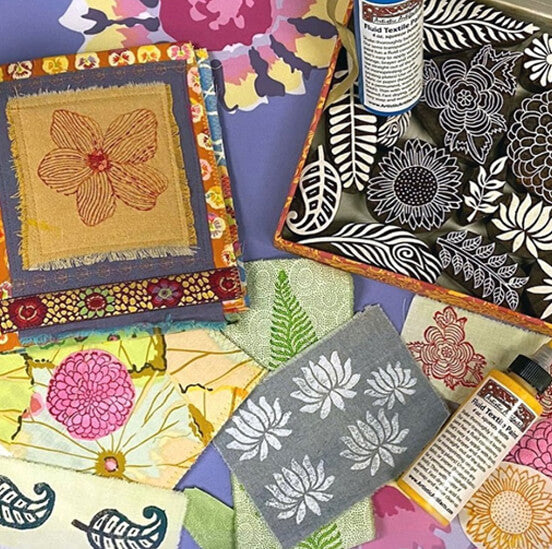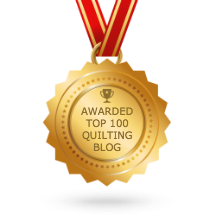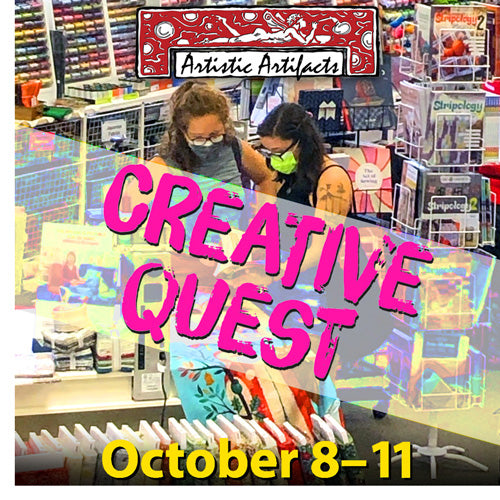Rusty Pumpkin Tutorial

What’s that old saying? When the cat’s away, the mice will play? When lead “cat” Judy left to drive her trailer full of goodies to Texas for both Quilt Market and International Quilt Festival, “mice” Julie Middleton and Sharon McDonagh took some time to play!
A previously posted tutorial on this blog introduced Rusty Paper by Viva Decor. We were asked by readers whether Rusty Paper could be used on fabric, so during our October session of How Do I Use This (which focused on Rusty Paper), we tried it out. We created mixed media tags that used both paper and fiber, including altering our Web Weave Ribbon with the product (see below).

To further explore the question of fabric, Julie and Sharon created this fun Halloween project.
Rusty Mixed Media Pumpkins Tutorial
Rusty Paper, available in original (dark rust) or Rust Orange, is a paint product that gives a realistic rust appearance and texture to paper, cardboard, wood, metal, plastic and more. Adding the Rusty Patina (available in Copper and Oxyd) makes the effect even more varied and realistic.

We used a black batik fabric as our base (doubling it up although we only painted one side), both deciding to cut out our pumpkins after we had painted the fabric. Julie chose to sketch out a pattern first (above). Sharon freehand cut her pumpkin’s facial features out of label stock and stuck them in place (below).

 We used the Rust Orange color of the Rusty Paper...an obvious choice since we were making Jack o’ Lanterns! It’s important to stir thoroughly the jar of Rusty Paper, which has a thick consistency (right), before you apply it to your chosen surface. Julie used a sponge to apply the product to her fabric; Sharon brushed it on over the label masks. Use either, or use a dauber, palette knife...whatever tool you like to apply the product to your surface.
We used the Rust Orange color of the Rusty Paper...an obvious choice since we were making Jack o’ Lanterns! It’s important to stir thoroughly the jar of Rusty Paper, which has a thick consistency (right), before you apply it to your chosen surface. Julie used a sponge to apply the product to her fabric; Sharon brushed it on over the label masks. Use either, or use a dauber, palette knife...whatever tool you like to apply the product to your surface.

Below, Sharon brushed too vigorously over the label paper mask masking the triangle nose and dislodged it, causing her to improvise a smaller, off center shape. Oh well...it was always meant to be a wonky pumpkin! Wash your brushes and tools as soon as you complete a step; once dried, this product is permanent.

Our pumpkin fabric dried after one coat:

Above, Julie intentionally left the black fabric to show through to give the impression of the ridges of the pumpkin. Below, Sharon peeled off the label masks after the first coat had dried.

We both added a second coat of Rusty Paper and introduced the Rusty Patina. The Patina adds a difference of both color texture, including some sparkle: so pretty! The technique is to work wet on wet, so we sponged and brushed on additional Rusty Paper and picked up differing amounts of Rusty Patina, wiping it into the Rusty Paper and swirling and mottling (see below). We used the Oxid color of the Patina so it would blend into the Rust Orange tones.

Once the second coat was dry, we cut, sewed and embellished our pumpkins.

Julie raided Judy’s button stash (above) for eyes and nose, and cut the mouth out of Osnaburg 100% cotton. This has a loose weave and is wonderful for stitching; because Julie sewed closed to the edge, it caused some fraying, which further added to the vintage feel she was going for!

We cut out our pumpkin shapes, leaving a raw-edged border of the black fabric. We then machine stitched with contrasting thread around the shape twice, leaving an opening at the top for stuffing and the stem. Although Julie didn’t have any trouble hand-sewing through the Rusty Paper, we didn’t want to run a sewing machine needle through it because of the gritty texture. (It may be possible to do so with no problem; experiment yourself if you wish).
Below, our finished pumpkins:

Julie used a length of tree branch for her stem, and accented it with orange skeleton leaves.

Sharon added book text (treated with a light coat of Rusty Paper and Rusty Patina) for cheeks and used peeled corrugated cardboard for her stem. She texturized green velvet with a rubber stamp, cut it into leaf shapes and glued them on, using a ribbon scrap for a tendril.
Lessons Learned
So, what did we learn about Rusty Paper on fabric? Sharon applied both coats rather thickly, wanting an opaque look. Peeling away the label masks she used, a small chip flaked off the edge of one of the pumpkin teeth, but the product otherwise adhered very well. Stuffing both of the sewn pumpkins with the fiberfill meant a lot of handling, yet there was no rub-off or cracking.
When most people ask about using a product on fabric, they usually mean they are wondering about permanence and washability. Rusty Paper and Rusty Patina are permanent products, and are even advertised to be used on decorative items that will be outdoors, so they have been formulated to stand up to the elements.
Below is a photo of textiles (Roc-lon Multi-Purpose Cloth and 100% cotton) that were stenciled with Rusty Paper during the How Do I Use This? session on October 8th.

We took the cotton swatch (far right in the above photo) and hand-washed it in a white plastic basin (so we could monitor the water for color loss). We used warm water and hand soap, agitating it with medium pressure and lightly scrubbing. We rinsed the swatch, and poured the wash water through layers of white paper towels, again so we could see if the color ran.

We did not see much loss of color (if any). But one of the hallmarks of this product is that it gives you a rust-like appearance, not just in color but in texture. Our pumpkins are rough and gritty feeling, much like a rusty piece of metal would feel. The left side of the above photo shows the residue left on the paper towel after draining: these are tiny, gritty flecks of color and product that gave the fabric its rusty texture.
Our recommendation? Feel free to use this product on any fabric, canvas or fiber product used to create a decorative object that won’t need regular laundering. That’s in addition to the surfaces recommended by the product manufacturers: paper, wood, metal, plastic, and more. This is a versatile product that gives you great effects!








Leave a comment